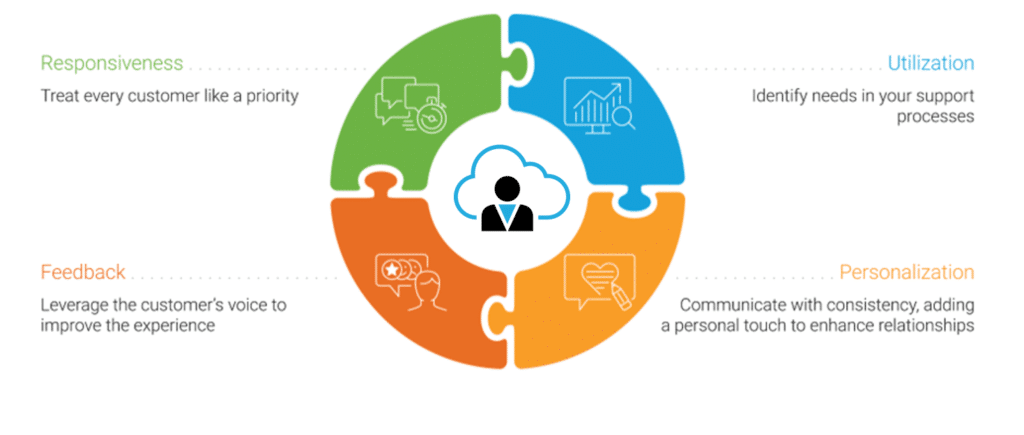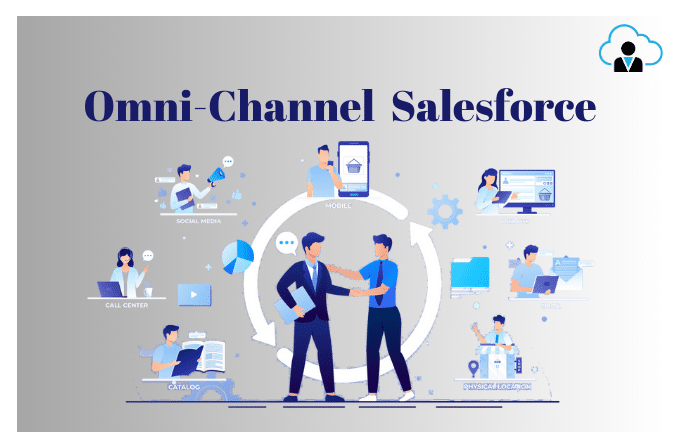Omni-Channel Salesforce: Customers expect smooth and customized experiences with businesses in the hyperconnected world of today. It takes careful planning to orchestrate various channels in order to create a seamless and outstanding customer experience if you want to live up to these expectations.
Enter Omni-Channel Salesforce, a revolutionary method of customer engagement that enables companies to communicate with clients over a variety of channels while delivering standardized, timely, and context-sensitive interactions.
We will examine the idea of Omni-Channel Salesforce, its importance, capabilities, best practices, and its transformative impact on contemporary customer involvement in this extensive 1,400-word post.

Table of Contents
ToggleThe Essence of Omni-Channel Salesforce
Omni-Channel A customer service strategy known as Omni-Channel or simply Salesforce makes use of the software’s sophisticated capabilities to deliver a seamless and uniform customer experience across a variety of channels and touchpoints. Email, chat, social media, phone, SMS, self-service portals, and more are examples of these channels. The main objective of Omni-Channel Salesforce is to eliminate silos between different channels so that organizations can interact with customers effectively and smoothly.

Key Elements of Omni-Channel Salesforce
Multi-Channel Presence: Businesses may create a presence on numerous communication channels with the help of Omni-Channel Salesforce, making sure they are reachable by clients via their preferred method of contact.
Real-Time Data Sharing: In order to give agents access to a complete customer history and context, regardless of where the engagement originated, it facilitates the sharing of client data and interactions in real time across channels.
Unified Agent Interface: A single interface that unifies all customer contacts from all channels is provided to agents, streamlining their workflow and enabling them to offer reliable and effective service.
Unified Agent Interface: Agents have access to a single interface that combines all client contacts from several channels, streamlining their workflow and enabling them to offer reliable and effective service.
Routing and Queuing: Based on skills, workload, and context, Omni-Channel Salesforce has automated routing and queuing systems that route client inquiries to the best and most readily available agent.
Context-Awareness: To preserve context across interactions, it makes use of data and automation. The agent is aware of the chat history, for instance, if a consumer starts a chat session and subsequently switches to a phone call.

The Significance of Omni-Channel Salesforce
Omni-Channel Salesforce is not just a trendy term; it is a crucial strategic component for companies hoping to survive in the cutthroat business environment of today. The following are some of the main arguments in favour of Omni-Channel Salesforce:

Enhanced Customer Experience: Customers will always receive consistent, individualized service because of Omni-Channel Salesforce. The experience is consistent and catered to their needs, whether they contact us via phone, chat, or email.
Efficiency and Productivity: Businesses can greatly increase the effectiveness of their support staff by consolidating client interactions into a single agent interface. Agents can manage numerous channels at once, speeding up response times and boosting output.
Data-Driven Insights: From client interactions, Omni-Channel Salesforce creates a plethora of data. Businesses can use this data to study customer behaviour, preferences, pain spots, and developing trends in order to make wise decisions.
Competitive Advantage: Superior omni-channel experiences can help firms stand out from the crowd. Customers are more likely to select businesses that offer responsive and hassle-free service.
Customer Retention: Customer loyalty is increased through regular, individualized contact. By resolving problems quickly and proactively, Omni-Channel Salesforce assists organizations in growing and maintaining their client base.
Scalability: Omni-Channel Salesforce can scale to meet increased demand while upholding service quality as organizations expand and client volumes rise.
Capabilities of Omni-Channel Salesforce
Omni-Channel Salesforce provides a variety of capabilities that enable companies to provide outstanding customer experiences. Here are some of the salient characteristics:

Channel Integration: Email, chat, social media, SMS, phone, and other methods of contact are all effortlessly integrated with Omni-Channel Salesforce. This enables customers to communicate with businesses via their preferred channel.
Unified Agent Console: A single, unified console that combines consumer interactions from numerous channels is available to agents. This dashboard offers a comprehensive picture of every client, replete with context and interaction history.
Intelligent Routing: According to parameters like expertise, availability, and workload, Omni-Channel Salesforce has intelligent routing capabilities that automatically route client inquiries to the best agent.
Real-Time Data Sharing: Real-time channel-to-channel sharing of client data and interaction histories ensures that customer service representatives have access to the most recent context and information.
Workforce Management: By keeping an eye on the productivity, workload, and reaction times of their agents, businesses can efficiently manage their support staff. This guarantees that tasks are evenly distributed and that resources are used effectively.
Automation and Chatbots: Omni-Channel Salesforce may incorporate chatbots and automation to handle regular requests and tasks, freeing up human agents to concentrate on more complicated problems.
Performance Analytics: The platform gives organizations access to analytics and reporting tools that let them monitor important performance indicators, gauge client happiness, and pinpoint areas for improvement.
Service-Level Agreements (SLAs): Organizations may set and enforce SLAs with Omni-Channel Salesforce, ensuring that customer inquiries are answered within predetermined times.
Best Practices for Implementing Omni-Channel Salesforce
Businesses should adhere to the following best practices in order to use Omni-Channel Salesforce properly and benefit from it:

Clearly Define Objectives: Clarify your omni-channel strategy’s objectives and aims before you do anything else. What do you hope to accomplish? improved sales, quicker reaction times, or higher customer satisfaction?
Comprehensive Training: Thoroughly instruct agents on the Salesforce Omni-Channel platform. Make sure they are capable of handling various channels, using the unified agent console, and preserving a consistent customer experience.
Data Management: Establish reliable data management procedures to guarantee data consistency and correctness across channels. Customer data that is accurate and current is necessary for context-aware interactions.
Monitor and Analyze: Keep an eye on channel effectiveness, customer happiness, and agent performance at all times. To acquire insights and implement data-driven improvements, use analytics tools.
Personalization: Utilize customer data to tailor communications. To provide individualized answers and suggestions, be aware of the preferences and histories of your customers.
Mobile Optimization: Make sure your Omni-Channel Salesforce setup is compatible with mobile devices. Customers frequently choose to interact with businesses on their mobile devices.
Feedback Loop: Create a feedback loop with your clients. Request feedback from them regarding their interactions, and use it to inform future interactions.
The Transformative Impact of Omni-Channel Salesforce
Implementing Omni-Channel Salesforce represents a strategic shift that can have a game-changing effect on businesses, not just a technological advancement. Here are some ways that it might transform client interaction and promote achievement:

Seamless Customer Journeys: Without losing context, customers can begin an encounter on one channel and move smoothly to another. They may start a chat session and then continue it over email or the phone, for instance.
Context-Aware Support: Agents are able to offer context-aware help because they have access to entire customer profiles and interaction histories. This results in fewer pointless inquiries and quicker problem-solving.
Increased Efficiency: Omni-Channel Salesforce organizes all client interactions into a single interface, streamlining agent tasks. This shortens handling times and improves agent efficiency.
Improved Customer Satisfaction: Customers value companies that make it simple to interact with them across channels. Businesses may increase client happiness and loyalty by providing a dependable and practical experience.
Data-Driven Insights: To learn more about consumer behaviour and preferences, make use of the abundance of data Omni-Channel Salesforce generates. These insights can be used by businesses to guide marketing and sales strategies and make educated decisions.
Competitive Advantage: Omni-channel customer engagement best practices give businesses a competitive advantage. In a saturated market, they are better positioned to attract and keep clients.
Scalability: Omni-channel Salesforce can scale to handle more client contacts as businesses expand. This scalability makes sure that even during times of heavy demand, client service is consistent.
Real-World Examples of Omni-Channel Salesforce
Numerous companies have used Omni-Channel Salesforce with success and realized the benefits of increased customer interaction. Here are a few actual instances:
Retail Giant: In order to integrate its online and in-store customer service, a major retail chain deployed Omni-Channel Salesforce. Now, customers can start support requests online, over chat, or over the phone and carry on the conversation in person. Increased in-store sales and improved customer satisfaction are the results of this.
Financial Institution: To deliver a uniform user experience across its website, mobile app, and call centre, a bank used Omni-Channel Salesforce. Customers don’t need to repeat information when they begin a transaction online and finish it over the phone. As a result, customers are exerting less effort and are more loyal.
E-commerce Company: Social media platforms were incorporated into an e-commerce company’s Omni-Channel Salesforce strategy. Through social media, customers can ask questions or place orders, and the interactions are smoothly transferred to agents who can help and finalize the transaction. Online sales and social media activity have increased as a result.
Conclusion
A revolutionary strategy for client engagement, Omni-Channel Salesforce enables companies to offer seamless, contextually aware, and tailored interactions over a variety of communication channels.
Businesses may improve customer satisfaction, promote efficiency, and gain a competitive edge by tearing down channel silos and unifying customer service.
Organizations should establish clear objectives, make a significant investment in thorough training, give data management first priority, keep track of performance, and embrace personalization if they want to realize the full potential of Omni-Channel Salesforce.
The impact of Omni-Channel Salesforce goes beyond technology; it has the ability to fundamentally alter how companies interact with and serve their clients, paving the way for sustained success and expansion in the current digital era.




